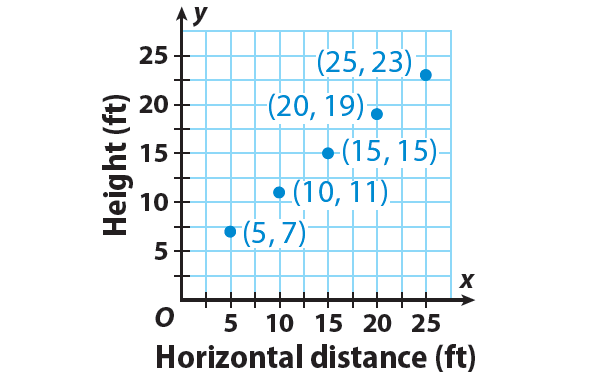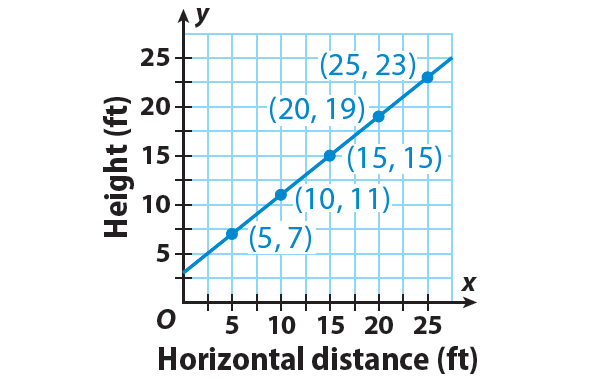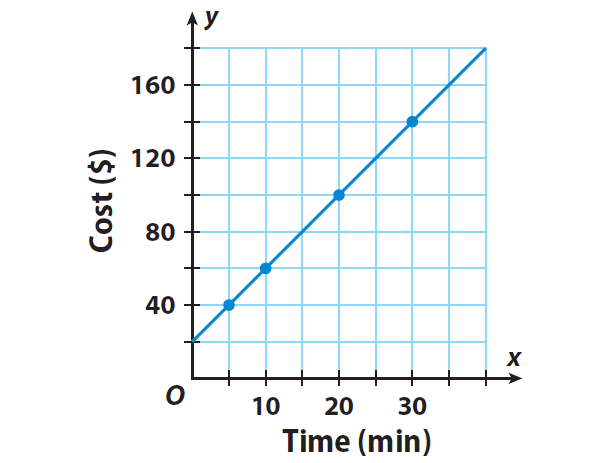LINEAR RELATIONSHIPS AND BIVARIATE DATA WORKSHEET
Problem 1 :
A handrail runs alongside a stairway. As the horizontal distance from the bottom of the stairway changes, the height of the handrail changes. Show that the relationship is linear, and then find the equation for the relationship.

Problem 2 :
The table shows the relationship between time and cost. Show that the relationship is linear, and then find the equation for the relationship.


Detailed Answer Key
Problem 1 :
A handrail runs alongside a stairway. As the horizontal distance from the bottom of the stairway changes, the height of the handrail changes. Show that the relationship is linear, and then find the equation for the relationship.

Solution :
Step 1 :
Connect the points in the graph given above.

Since all of the points (5, 7), (10, 11), (15, 15), (20, 19), and (25, 23) lie on the same line, the relationship is linear.
Step 2 :
Choose any two points in the form (x, y), from the graph to find the slope :
For example, let us choose (5, 7) and (10, 11).
Use the slope formula.
m = (y2 - y1) / (x2 - x1)
Substitute :
(x1, y1) = (5, 7)
(x2, y2) = (10, 11)
Then,
m = (11 - 7) / (10 - 5)
m = 4 / 5
m = 0.8
Step 3 :
Choose a point and use the slope to find the value of 'b' (y-intercept b).
Substitute the point (5, 7) and m = 0.8 in the equation
y = mx + b
7 = (0.8)(5) + b
7 = 4 + b
3 = b
Step 4 :
To get the equation of the given linear relationship, substitute m = 0.8 and b = 3 in the equation y = mx + b.
y = 0.8x + 3
Problem 2 :
The table shows the relationship between time and cost. Show that the relationship is linear, and then find the equation for the relationship.

Solution :
Step 1 :
From the table, write the points in the form (x, y).
(5, 40), (10, 60), (20, 100) and (30, 140)
Step 2 :
Plot all the points in a graph paper and connect them.

Since all of the points (5, 40), (10, 60), (20, 100) and (30, 140) lie on the same line, the relationship is linear.
Step 3 :
Choose any two points in the form (x, y), from the graph to find the slope :
For example, let us choose (5, 40) and (10, 60).
Use the slope formula.
m = (y2 - y1) / (x2 - x1)
Substitute :
(x1, y1) = (5, 40)
(x2, y2) = (10, 60)
Then,
m = (60 - 40) / (10 - 5)
m = 20 / 5
m = 4
Step 4 :
Choose a point and use the slope to find the value of 'b' (y-intercept b).
Substitute the point (5, 40) and m = 4 in the equation
y = mx + b
40 = (4)(5) + b
40 = 20 + b
20 = b
Step 5 :
To get the equation of the given linear relationship, substitute m = 4 and b = 20 in the equation y = mx + b.
y = 4x + 20
Kindly mail your feedback to v4formath@gmail.com
We always appreciate your feedback.
©All rights reserved. onlinemath4all.com
Recent Articles
-
Solving Equations with the Given Roots
Jan 23, 25 04:57 AM
Solving Equations with the Given Roots -
Given Composite Function : How to Find the Inside or Outside Function
Jan 22, 25 02:43 AM
How to Find the Inside or Outside Function From the Given Composite Function -
SAT Math Resources (Videos, Concepts, Worksheets and More)
Jan 20, 25 09:31 PM
SAT Math Resources (Videos, Concepts, Worksheets and More)